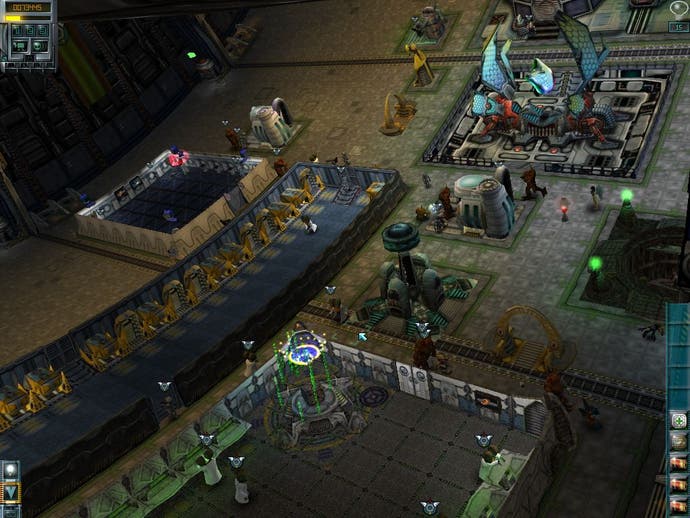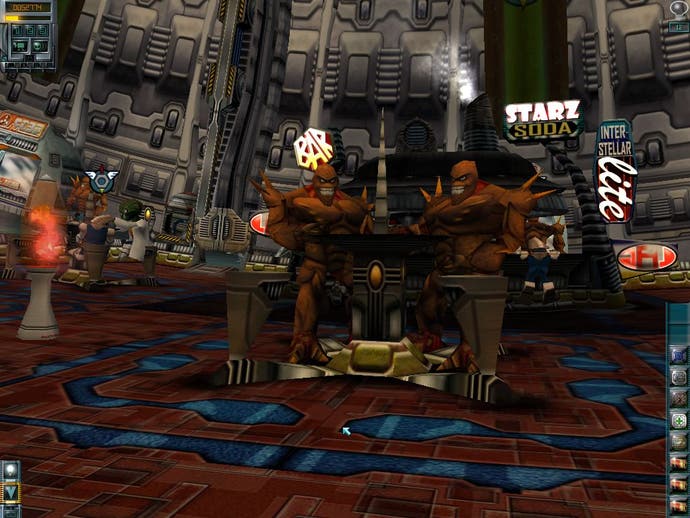Startopia
Review - EuroGamer heads for the final frontier to probe Mucky Foot's bizarre space station sim
Imagine if the Death Star had been privatised, or if the jokers behind the Millenium Dome were let loose on Babylon 5. Add a cast of bizarre aliens, from your standard grey Reticulan to giant four-armed purple hippies and swimsuit-wearing sirens. Throw in a healthy dose of humour inspired by the late great Douglas Adams, and garnish with pop culture references to the likes of Star Wars and Plan 9 From Outer Space. Simmer gently for three years, et voila - Startopia!

Room With A View
Hand-crafted by the natives of exotic Guildford, Startopia puts you in charge of refurbishing a network of donut-shaped space stations which were abandoned during a recent war. Starting with just a few maintenance robots, an energy collector and some loose change, you must take control of your station deck by deck, segment by segment, constructing industrial facilities, space docks, security stations, holodromes and luxury hotels to attract visitors.
In all there are more than forty different types of room to construct, not to mention a wide selection of furniture ranging from operating tables and Z-ray scanners for the sick bay, to big fluffy chairs and lava lamps for your love nests. You will also need to hire the right staff, as each of the game's nine main races has its own speciality, and your workers will automatically assign themselves to the appropriate tasks. For example, the Groulien Salt Hog is your average working class alien, doing the dirty work in recycling plants and factories, while the Greys are naturally adept at medical procedures, having spent most of the last few decades probing surprised looking humans.

Energy Drain
Each space station is divided into three decks, the outermost of which is the engineering deck, where passing ships dock to trade and unload passengers. It houses your industrial, security and medical facilities, and more importantly your energy collectors. Energy is the game's main resource, and as well as powering your rooms it also acts as a currency to buy supplies, construct facilities and hire new staff.
This can be something of a problem unfortunately, because a spate of deaths can leave you with negative energy thanks to compensation claims from the victims' families. At this point everything on your space station will shut down, including your power boosters (which normally increase the amount of energy you generate), space docks (where trade is carried out) and ports (where foot passengers disembark). Isolated from the rest of the universe, you will soon find your aliens suffering from hunger and disease as your sick bays and food dispensers go offline. And as more aliens die, you just spiral deeper and deeper into debt. Luckily this doesn't happen very often, but when it does it can obviously be a little frustrating, and usually the only way to recover is to quit the mission and restart from an old auto-save position.
Combat is also a little hit and miss, playing a bigger role than in most sims but lacking the control of a real-time strategy game. Up to four managers can be fighting over a single station, and sooner or later you will need to occupy their territory, one segment at a time, using security droids to breach bulkhead doors and gain control of computer systems. Some of your aliens will join in the fight as you invade the enemy segment, but all you can do to direct them is to set up muster points and frantically click on the aliens and buildings you want your troops to attack. It's far too easy for an enemy security droid to sneak past the brawling aliens and shut the doors again before you can destroy it, and when this happens any droids caught on the wrong side of the doors will self-destruct, and any of your employees that get left behind will abandon your cause and stay there. As a result battles can be rather chaotic, and if you have the money it generally pays to hire first and ask questions later - the more aliens you can pour into the enemy sector when a fight breaks out, the better your chances.

I'm Just Sitting Watching Flowers In The Rain
The rest of the game is played at a slightly more sedate pace though, and you can often find time to chill out and watch the flowers grow on the bio deck, or follow your aliens around the hotels and bars of the entertainment deck.
Mucky Foot have done a great job of bringing the space station to life, and it looks even better in motion than it does in the screenshots. Your aliens are always up to something, moshing in the disco, chatting with each other, stopping to admire a statue, enjoying a swift pint at the local bar, or running away screaming (silently - this is space, after all) as a giant black beetle that appears to have escaped from Starship Troopers drops in for a little light refreshment.
The flexible camera helps to put you right in the middle of all this action. As in Black & White you can zoom right in to view your inhabitants up close or pull way back through the windows of the bio deck to see the entire space station spinning through the void. Unlike Black & White, the controls for the camera are incredibly intuitive, especially if you have a three button mouse. There's even a great shoulder cam option which tracks an alien as it wanders around the station, showing you where it goes and what it sees.

Your Mission, Should You Choose To Accept It
Introducing you to this toroidal world is a series of short tutorials which teach you the basic controls and economics of the game, easing you into the action one step at a time from building your first rooms to hiring staff, landscaping the bio deck and fighting off rival space station managers.
Startopia also includes a series of ten longer missions which see you working for each of the game's alien races, with tasks including evicting squatters, setting up a hospital station and turning your bio deck into a veritable horn of plenty. There's a nice smooth learning curve throughout, and each mission opens up new technologies and alien races to you. By the time you've finished the campaign (and been treated to the amusing Empire Strikes Back parody in the closing cinematic) you will be ready to sink your teeth into the piece de resistance - the sandbox mode.
This allows you to customise the game to suit your own tastes, setting how much energy you start out with, how many rival managers (if any) are on the station with you, whether you can engage in open warfare with them, and how frequently random events like starquakes and solar flares will occur. You can also adjust finishing conditions - earn a certain amount of energy, occupy enough segments of the station, research new technologies etc - or simply leave the game open-ended. And if pounding the AI gets boring, up to four players can battle it out online, with the same wide range of options available.
Conclusion
Startopia is more of a toy than a game in the traditional sense of the word, and playing with your aliens and messing around in their world can be a lot of fun, even without the pressure of rival managers to defeat. It's not a game that takes itself too seriously either, from the parody of 2001 in the opening cinematic to the alien visitors who list their hobbies as mutilating cattle and hovering over Mexico City. And although every station is exactly the same size and shape, the variety of missions included and the endless permutations available in the sandbox and multiplayer modes mean that you aren't likely to get bored in a hurry. One of the best strategy games we've seen so far this year, and also one of the funniest.

